For adventure seekers looking to immerse themselves in the untamed beauty of the Annapurna region, the Mardi Himal Trek during the monsoon season in August offers a unique and exhilarating experience. While the thought of trekking during the rainy season may seem daunting, it unveils a different perspective on the Mardi Himal Trek, showcasing nature’s resilience and unveiling hidden treasures along the way.

While many trekkers flock to popular trails like Everest Base Camp or Annapurna Circuit, the Mardi Himal Trek remains a hidden gem, revealing its true splendor during the mystical monsoon months. In this blog, we will explore the captivating charm of trekking Mardi Himal in August, where rain–washed trails, lush landscapes, and the thrill of the monsoon create a truly unforgettable adventure.
Weather Conditions and Temperature
If you’re planning to trek in August during the monsoon season, it’s essential to understand the weather conditions and temperatures to make the most of your journey. Let’s dive into what you can expect during this time of the year.
Monsoon Season in Nepal
Nepal experiences its monsoon season from June to September, with August being one of the wettest months. The monsoon is characterized by heavy rainfall, cloudy skies, and high humidity.

While trekking during this time can be challenging due to the rain, it also brings its unique charm with verdant landscapes and fewer crowds on the trail.
Weather Conditions
August is known for its abundant rainfall in the Mardi Himal region. Expect frequent showers, often accompanied by cloudy skies. The monsoon rains are typically intense, but they are often followed by periods of sunshine. It’s important to be prepared for both rain and sunshine during your trek.
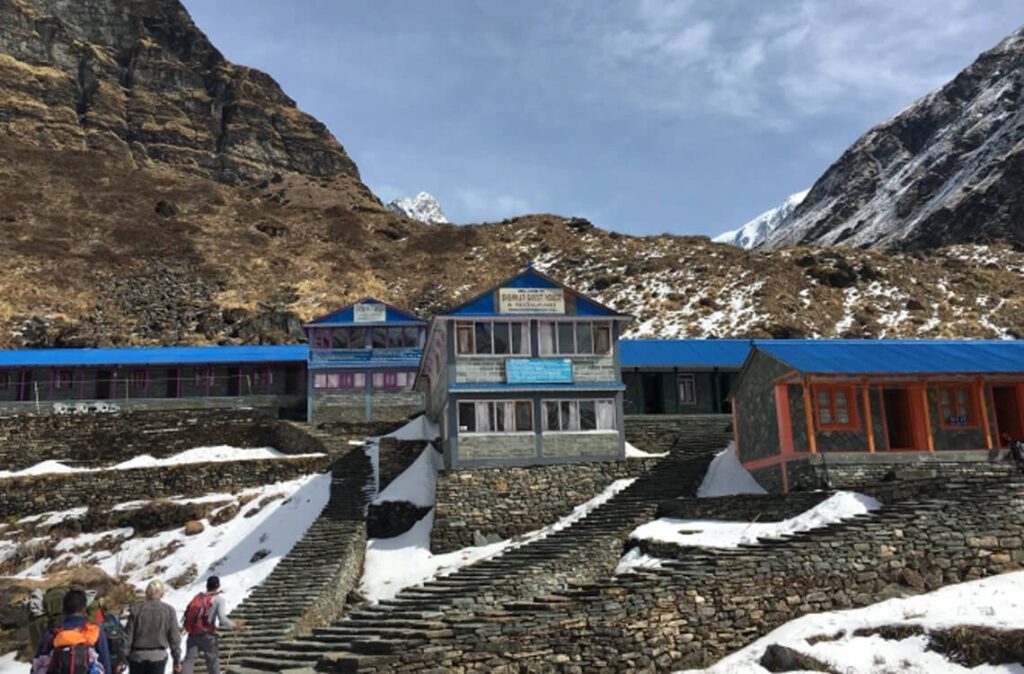
During the monsoon season, the skies might be overcast, limiting the visibility of the towering peaks. However, there are moments when the clouds part, granting you breathtaking views of the Annapurna and Machhapuchhre (Fishtail) peaks. The lush vegetation, adorned with blooming flowers, adds an extra touch of beauty to the surroundings.
Temperature Range
In August, the temperatures in the Mardi Himal region tend to be relatively mild and pleasant providing favorable conditions for trekking. However, it’s important to note that the temperatures can vary significantly depending on the altitude.
Also Read: Mardi Himal Trek in January: Weather, Difficulty, Temperature, Travel Tips, and More
At lower altitudes (around 1,700 meters/5,577 feet), you can expect daytime temperatures ranging from 20°C to 25°C (68°F to 77°F). As you ascend to higher elevations, such as the Mardi Himal Base Camp at approximately 4,500 meters (14,764 feet), temperatures drop to around 5°C to 10°C (41°F to 50°F) during the day and can dip below freezing at night. Proper layering of clothing is crucial to stay comfortable and warm during chilly nights.
Highlights of Mardi Himal Trek in August
Let’s take a look at the highlights of this awe-inspiring trek that takes you on a remarkable journey through lush forests, cascading waterfalls, and misty mountains.
The Tranquil Beauty of Lush Greenery
August marks the onset of the monsoon in Nepal, infusing the landscape with vibrant shades of green. As you embark on the Mardi Himal Trek, you’ll be greeted by dense forests of rhododendron, oak, and maple trees, draped in an emerald cloak.
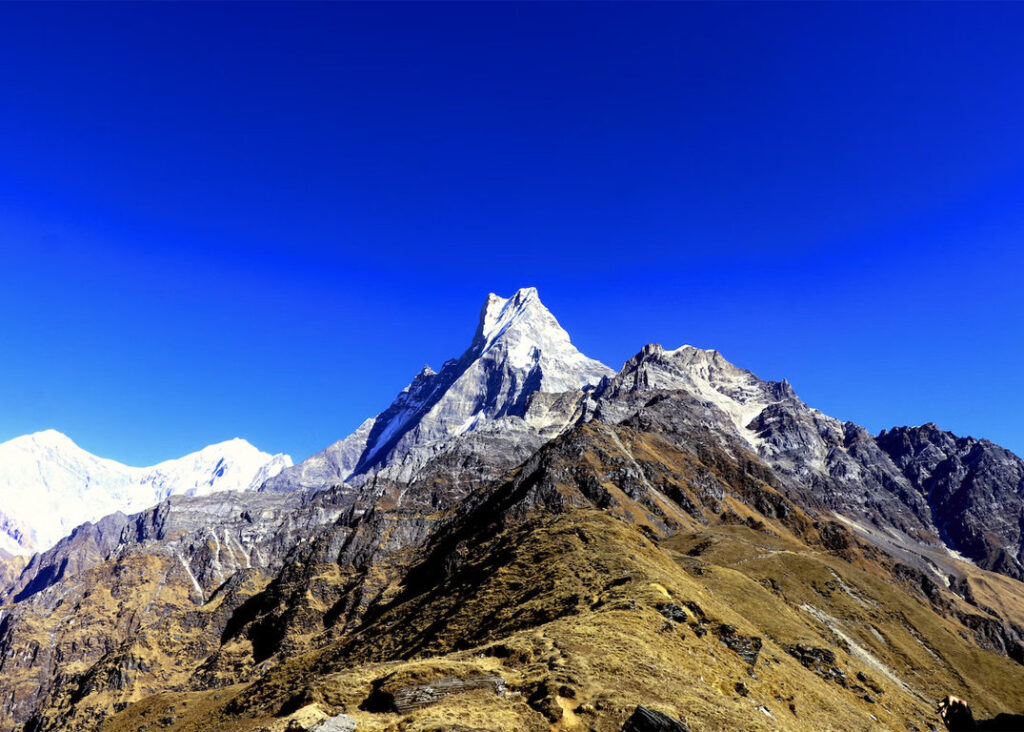
The monsoon showers breathe life into these woods, creating a serene and otherworldly atmosphere that is a feast for the senses.
Refreshing Waterfalls and Enchanting Streams
The monsoon season blesses the region with an abundance of rainfall, giving rise to countless waterfalls and streams along the trekking route. As you make your way through the trail, you’ll witness cascades of water gushing down steep cliffs, their thunderous roars creating a symphony of nature.
Read: Mardi Himal Trek in February: Weather, Difficulty, Travel Tips, and More
These majestic waterfalls, coupled with the misty atmosphere, create a mystical ambiance that’s hard to replicate during other seasons.
Fewer Crowds, More Serenity
One of the major advantages of trekking the Mardi Himal Trek in August is the reduced number of fellow trekkers. While other popular trails are crowded, the Mardi Himal Trek provides an opportunity for solitude and tranquility.
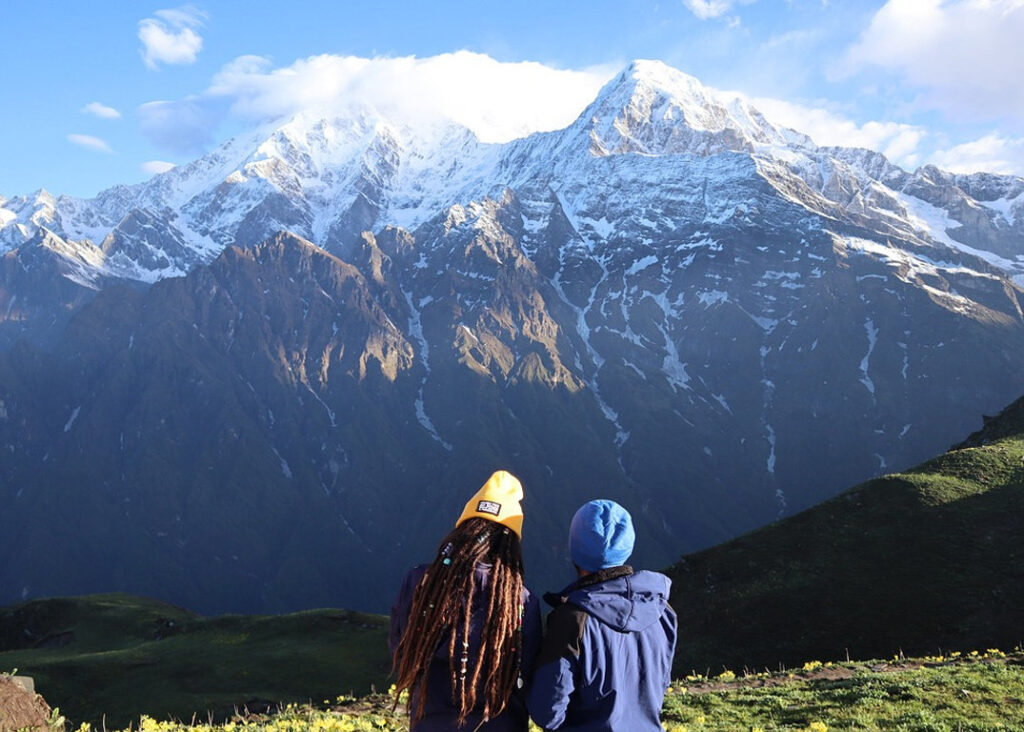
You’ll have more space to immerse yourself in the raw beauty of nature allowing for a deeper connection with the surroundings. It’s a chance to escape the hustle and bustle of daily life and reconnect with your inner self.
Panoramic Views Amidst Clouds
The ever-changing weather patterns during the monsoon season bring about stunning vistas that are uniquely mesmerizing.

As clouds sweep across the landscape, occasionally unveiling glimpses of towering peaks like Machapuchare (Fishtail), Annapurna South, and Hiunchuli, you’ll be left in awe of nature’s dramatic artistry. The interplay of mist, clouds, and sunlight creates a dreamlike panorama that will forever be etched in your memory.
You May Also Like: Mardi Himal Trek In March: Weather, Difficulty, Route, Travel Tips, and More
Cultural Encounters and Warm Hospitality
The Mardi Himal Trek takes you through traditional villages and introduces you to the warm and welcoming locals. August is an excellent time to immerse yourself in the local culture, as communities celebrate vibrant festivals such as Janai Purnima and Krishna Janmashtami.
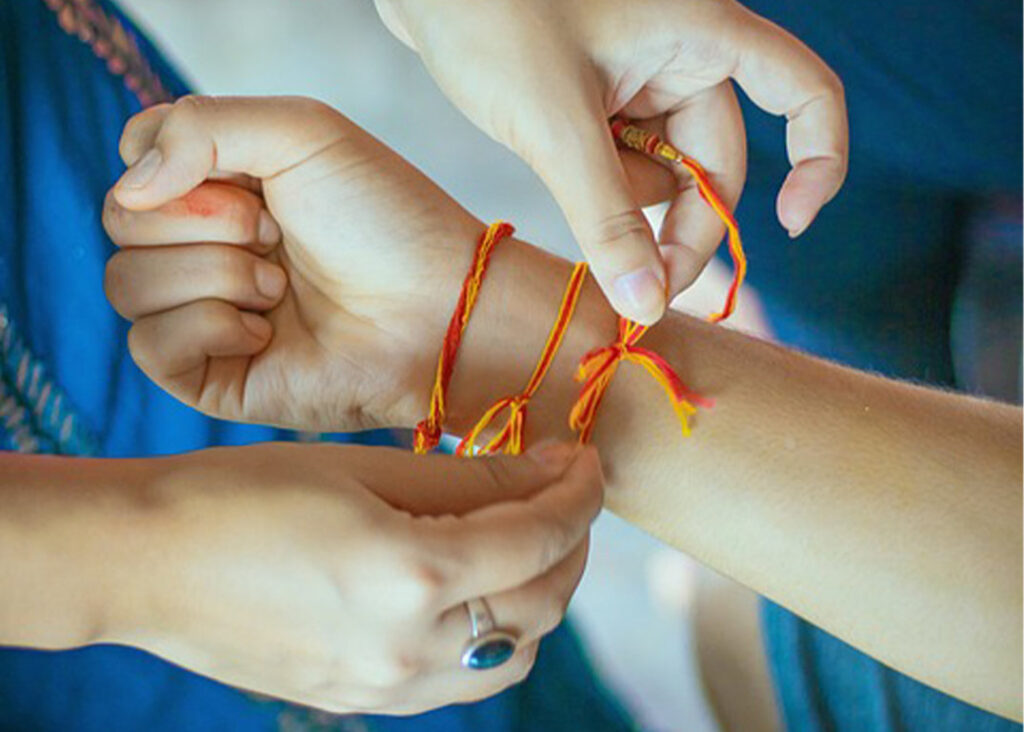
You’ll have the opportunity to witness traditional rituals, interact with friendly villagers, and gain a deeper understanding of the region’s rich heritage.
A Chance to Embrace Adventure
While trekking during the monsoon season requires preparedness, it also adds an element of adventure to your journey. Navigating the occasional muddy trails and crossing gushing streams can be exhilarating, offering a sense of accomplishment as you overcome nature’s obstacles.
Also Check: Mardi Himal Trek in April: Temperature, Difficulty, Travel Tips, and More
With the right gear and a positive mindset, the monsoon becomes an ally rather than a hindrance.
Challenging Yet Rewarding Trekking Conditions
While the monsoon season brings rain and occasional challenges, it also presents an opportunity to test your trekking skills. The trails might be muddy and slippery, requiring extra caution and proper trekking gear.

However, successfully navigating these conditions adds an element of achievement and resilience to your journey. The challenging terrain and unpredictable weather make the Mardi Himal Trek in August an adventure that pushes your limits and rewards you with breathtaking views and a sense of accomplishment.
A Journey of Self-Discovery
The Mardi Himal Trek in August is not only an opportunity to explore the beauty of nature but also a chance for personal introspection. The tranquility and solitude of the trek allow for moments of self-reflection and contemplation.
Also Read: Mardi Himal Trek in July
As you disconnect from the noise of everyday life and immerse yourself in the raw wilderness, you may find clarity, peace, and a renewed sense of purpose.
Kathmandu to Mardi Himal Trek
To reach Mardi Himal Trek from Kathmandu, start by taking a short flight to Pokhara. From there, travel by taxi or shared jeep to Kande, the trek’s starting point. Begin hiking to Australian Camp, followed by Forest Camp, and then proceed to Low Camp. Ascend to High Camp, where you’ll experience stunning mountain views.

Finally, make your way to Mardi Himal Base Camp, the trek’s highlight. The journey involves a combination of flights, road transportation, and several days of hiking through diverse landscapes and vegetation. Hiring a local guide or joining a trekking agency is recommended for a safe and enjoyable experience.
You May Also Like: Mardi Himal Trek in June
Festivals
Let’s take a look at some of the festivals that can be spotted during the Mardi Himal Trek in August.
Janai Purnima
Janai Purnima, also known as Raksha Bandhan or Sacred Thread Festival, is a prominent Hindu festival celebrated throughout Nepal. It usually falls in the month of August. During the Mardi Himal Trek, you may have the chance to witness this auspicious festival in the traditional Gurung and Magar villages along the trail.

The festival holds significant cultural and religious importance as men change their sacred thread (Janai) and receive blessings from priests. Colorful threads are also tied around the wrists of family members, symbolizing the bond of protection and love.
Krishna Janmashtami
Krishna Janmashtami, the birth anniversary of Lord Krishna, is one of the most significant festivals for Hindus. Celebrated with great zeal and devotion, this festival usually falls in August. While on the Mardi Himal Trek, you might encounter small Krishna temples or shrines in villages along the way.
Interesting: Mardi Himal Trek in May
Devotees observe fasts, chant prayers, and engage in various cultural activities to commemorate Lord Krishna’s birth. The festivities create a vibrant and spiritual ambiance, with joyous processions, music, dance, and the sharing of traditional sweets.
The difficulty level of the Mardi Himal trek in August
Undertaking this trek during the monsoon season in August poses its own set of challenges. Let’s explore the difficulty level of the Mardi Himal Trek in August and provide insights on how to make the most of this unique experience.
Weather Conditions
August falls within Nepal’s monsoon season, which means you can expect abundant rainfall during your trek. The weather can be unpredictable, with rain showers occurring frequently throughout the day.
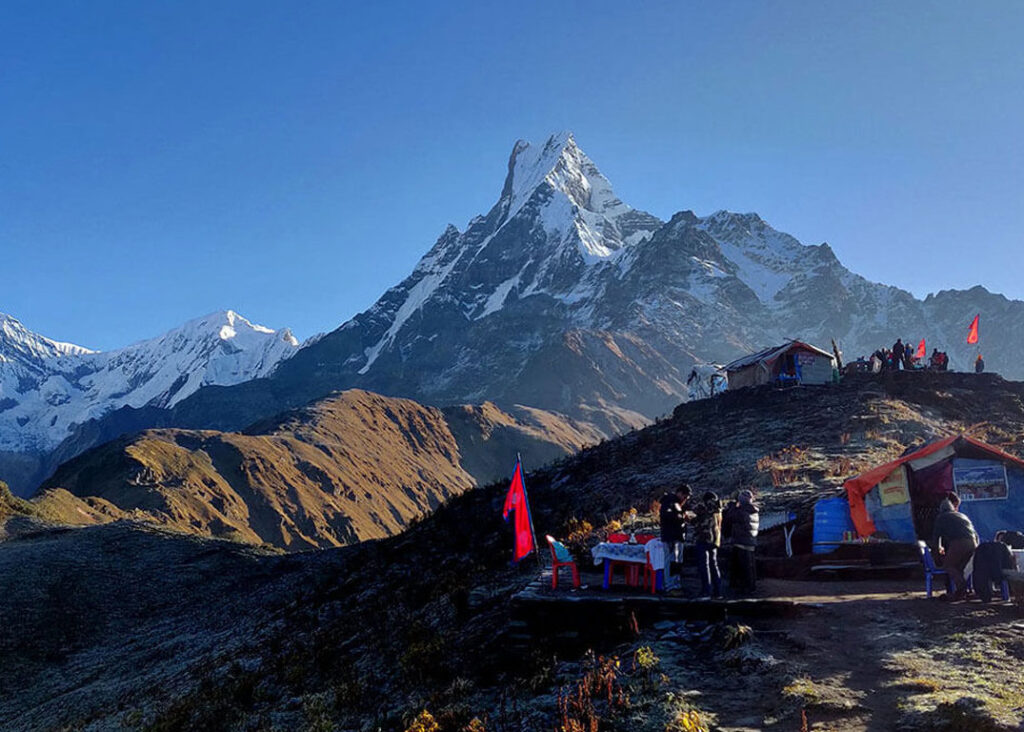
This can make the trails slippery and more challenging to navigate. It is essential to come prepared with appropriate rain gear, waterproof hiking boots, and trekking poles to ensure safety and comfort.
Trail Conditions
The Mardi Himal Trek offers a beautiful mix of terrains, including lush forests, terraced fields, and alpine meadows. However, the monsoon season brings a higher risk of landslides and avalanches due to the saturated ground and unstable slopes.

It is advisable to stay updated on the local weather conditions and consult with experienced guides or trekking agencies who can provide accurate information on trail conditions. Flexibility in your itinerary is crucial, as route adjustments may be necessary due to safety concerns.
Increased Difficulty
The monsoon season adds an additional layer of difficulty to the Mardi Himal Trek. The trails become muddier and more slippery, requiring extra caution and slower progress. Steep ascents and descents can become challenging, and river crossings may be more hazardous due to higher water levels.

Physical fitness and endurance are essential to tackle the demanding terrain. Prior trekking experience is beneficial, although not mandatory, as long as you are prepared for the unique challenges the monsoon season brings.
Tips
To make the most of your Mardi Himal Trek in August, consider the following tips:
- Pack appropriate rain gear, including a waterproof backpack cover and dry bags for electronic devices.
- Carry extra pairs of socks and quick-drying clothing to stay comfortable in wet conditions.
- Stay hydrated by drinking plenty of water, even if the weather feels cooler due to rain.
- Engage an experienced guide or join a reputable trekking agency to ensure safety and navigation.
- Start your trek early in the day to avoid the heavier afternoon rainfall.
- Be prepared for route alterations or potential rest days due to adverse weather conditions.
Let our expert team at Asian Heritage Treks and Travel take care of everything — from guided tours to personalized packing tips and travel arrangements.
Plan a fun adventure







